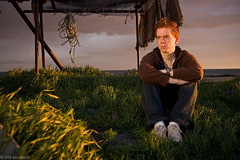Here is an example image to help explain:

Most modern DSLRs have two shutter doors, a top and a bottom one. When you press the shutter button, the top one starts to raise, and then the bottom one starts to follow, till they both meet, closed, at the top. The speed you set your shutter will determine the time between when the top door starts moving and the bottom door follows (your camera make/model also can affect this).
Your max sync speed is essentially the setting at which the top door has reached the top of the sensor before the bottom door has started moving. It provides an entirely unobstructed view of the sensor for the flash to come in. A flash's duration is around 1/4000 or faster, so it will always be fast enough to hit the sensor for only a fraction of your shutter duration.
If you set your camera to faster than max sync speed, say 1/320 of a second, when your flash fires, the bottom door will already have started upward, and will be blocking a portion of the sensor from getting flash. This will cause a black bar at the bottom of the image. If you go too fast, say 1/1000, you will get a black bar from both the top door and bottom door. At this speed, the opening of the shutter is essentially a small slit moving across the sensor. The bottom door starts moving almost immediately after the top door starts. This will give you a black bar on top and bottom of the image.
Some point/shoot cameras, like the Canon g9, have electronic shutters, meaning that rather than using a physical door, the camera merely shuts off the sensor. This results in being able to sync around 1/4000. There is no door in the way of the flash.
Ambient is unaffected by this property. That's why most flash photographers start their camera at their max sync speed (1/200 or so), get the flash value correct, then start lowering the shutter speed to allow in more background light. I mentioned that the flash duration is only 1/4000 of a second or faster, so it will hit the sensor the same at 1/200 as it does at 1/5 of a second. Only ambient will be affected by this change in time.
When shooting with both flash and ambient, you get an opportunity to balance the flash intensity with background intensity.
For example:

This shutter speed is 1/125. If I changed it to 1/200, the sky would be darker, and the sunlight on his right cheek would be a bit dimmer. If I changed the shutter speed to 1/60, the sky would be much brighter, and the sunlight on his cheek even brighter. The flash fill on the left of his face would be unaffected by the shutter speed change.
You can see how this gives you power to alter your light ratios, background to foreground values, and overall scene control.


I believe, not 100% sure that most DSLR's have a combination of mechanical and electric shutters as making a shutter that can do 1/4000 is very expensive and more prone to breaking. I think most DSLR's max mechanical shutter speed is around 1/250 and after that the shutter speed is electronically shortened which can sometimes allow you to go above 1/250 sync speed.
ReplyDeleteActually only a few do the combination thing. The reason that 1/4000 can be done, is that traveling slit principle. There is a tiny slit of light sliding across at such a speed that each photosite is only showing through the slit for 1/4000 of a second. It would indeed be expensive to make a shutter than can move the door across the sensor at 1/4000 of a second.
ReplyDeleteOnly point/shoots and some older Nikon dslrs use combo mechanical/electronic, as far as I understand it.
finally, an explanation that makes sense!
ReplyDeleteIt's worth mentioning high-speed flash options--High Speed Sync in Canon, Auto FP in Nikon, X-Sync in Pentax--can give you a slightly-faster sync time at the expense of recycle speed and battery life. What they're actually doing is firing a bunch of smaller flash bursts as the shutter doors reveal new areas of the sensor (since the entire is never visible at once).
ReplyDeleteIt doesn't work very well for off-camera flashes, and you need to be using 1st-party hardware for everything to work.
Actually, Nikon Auto FP triggers a longer, continuous flash instead of a burst.....
ReplyDelete1/200 is slower that 1/125 as is 1/60. Why then is not the sky lighter at both those settings? What am I missing?
ReplyDelete1/200 is not slower than 1/125. it's faster, you got it backwards. Fractions of a second.
DeleteThis is helpful information for understanding how max sync speed affects photography.
ReplyDelete